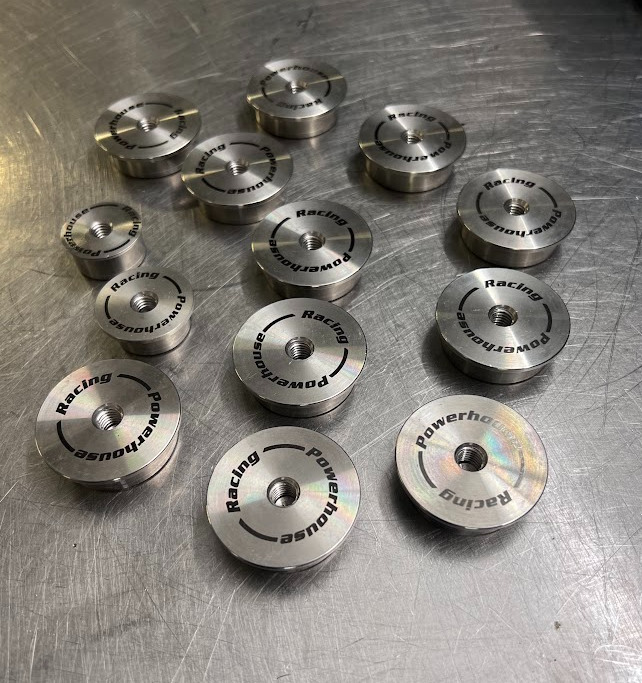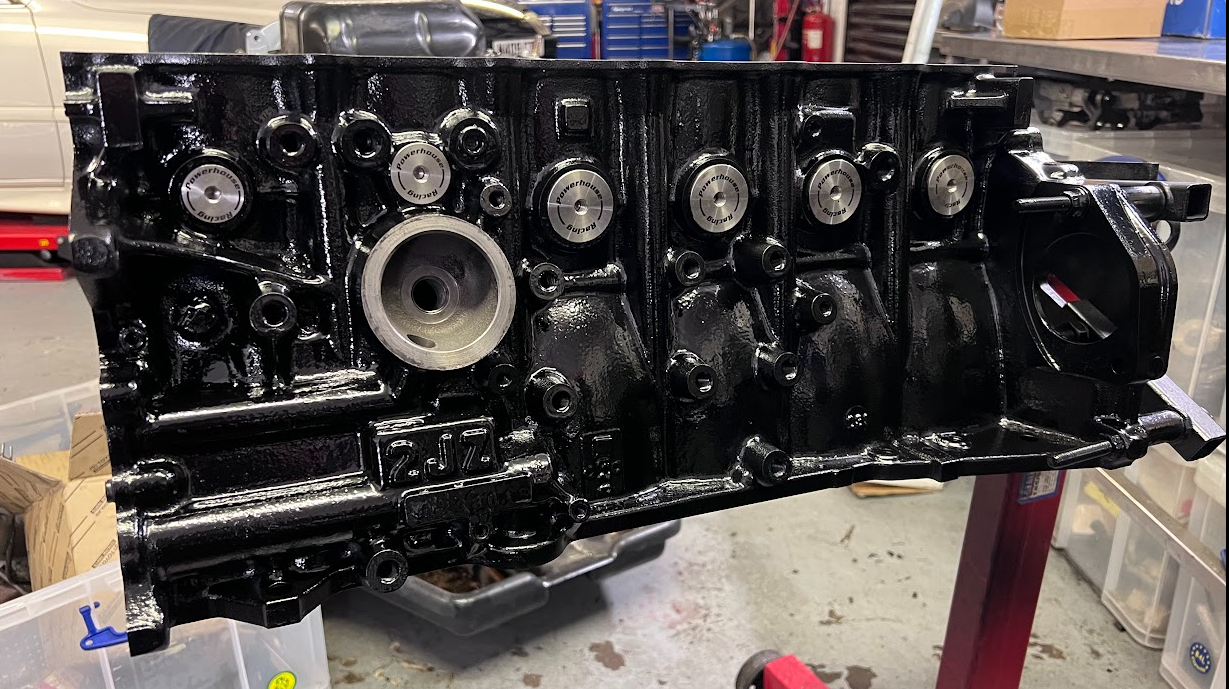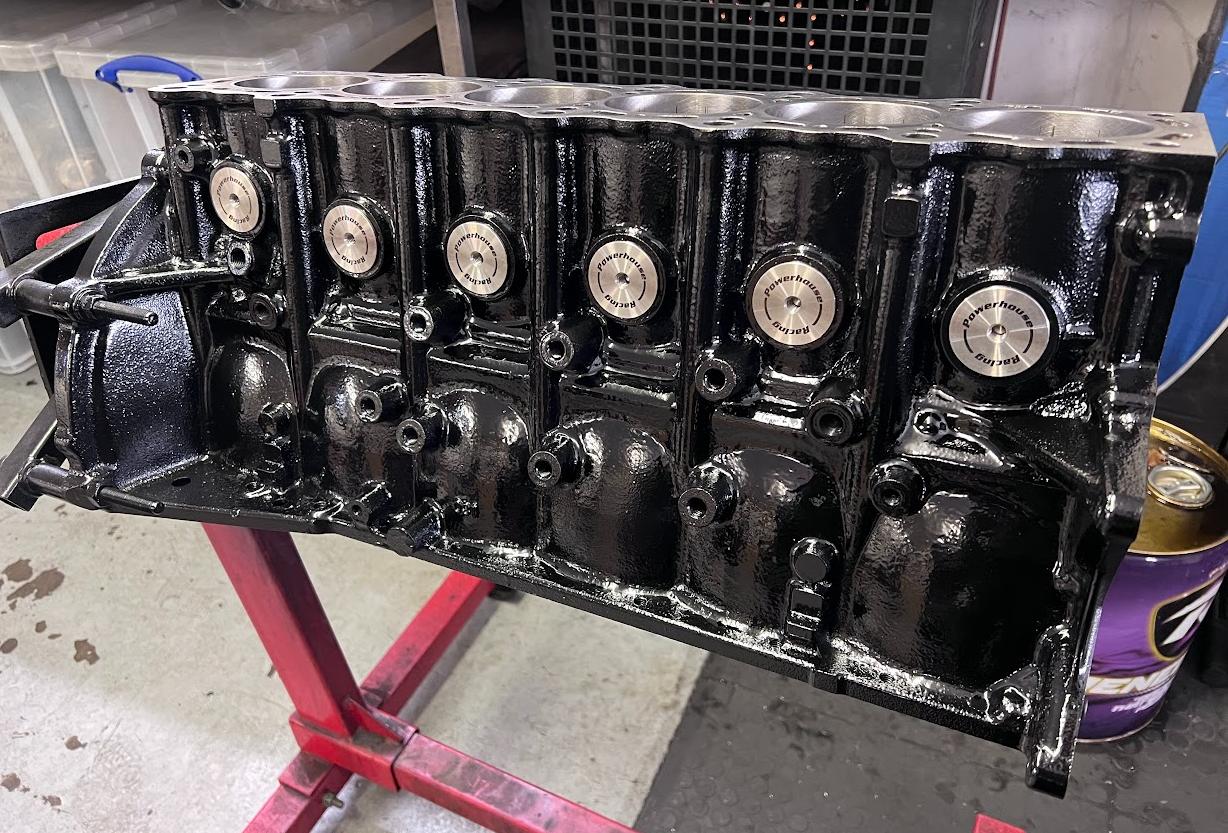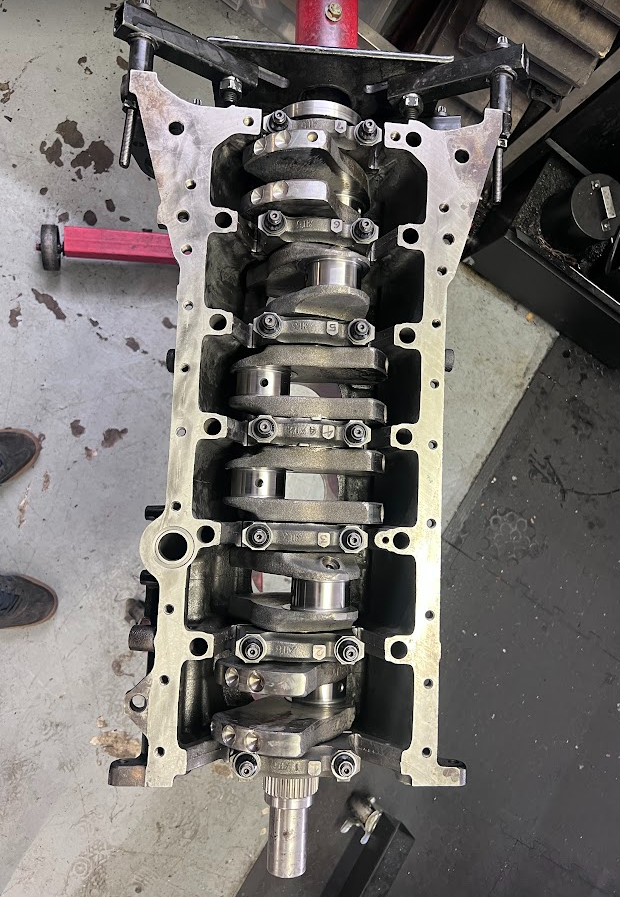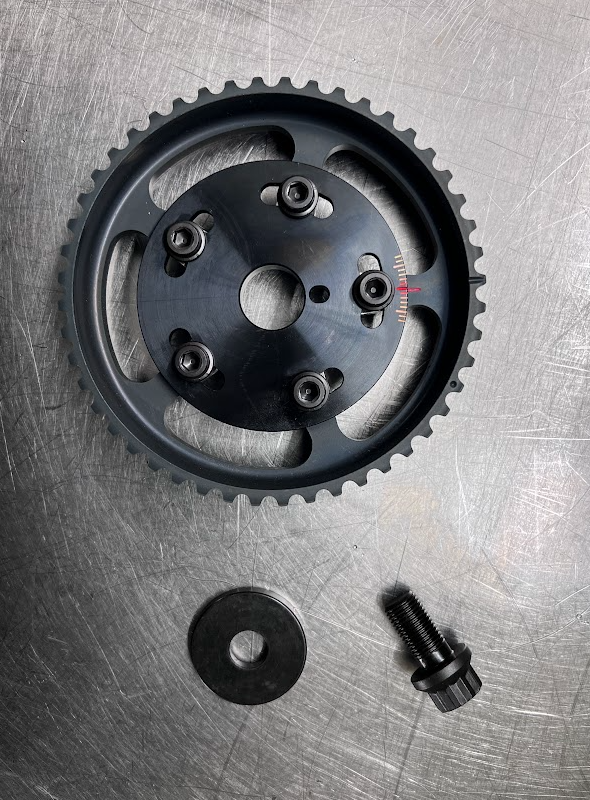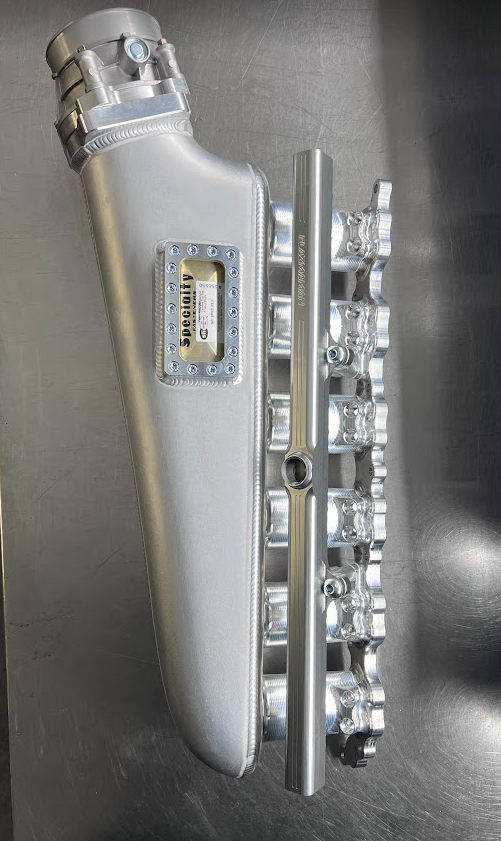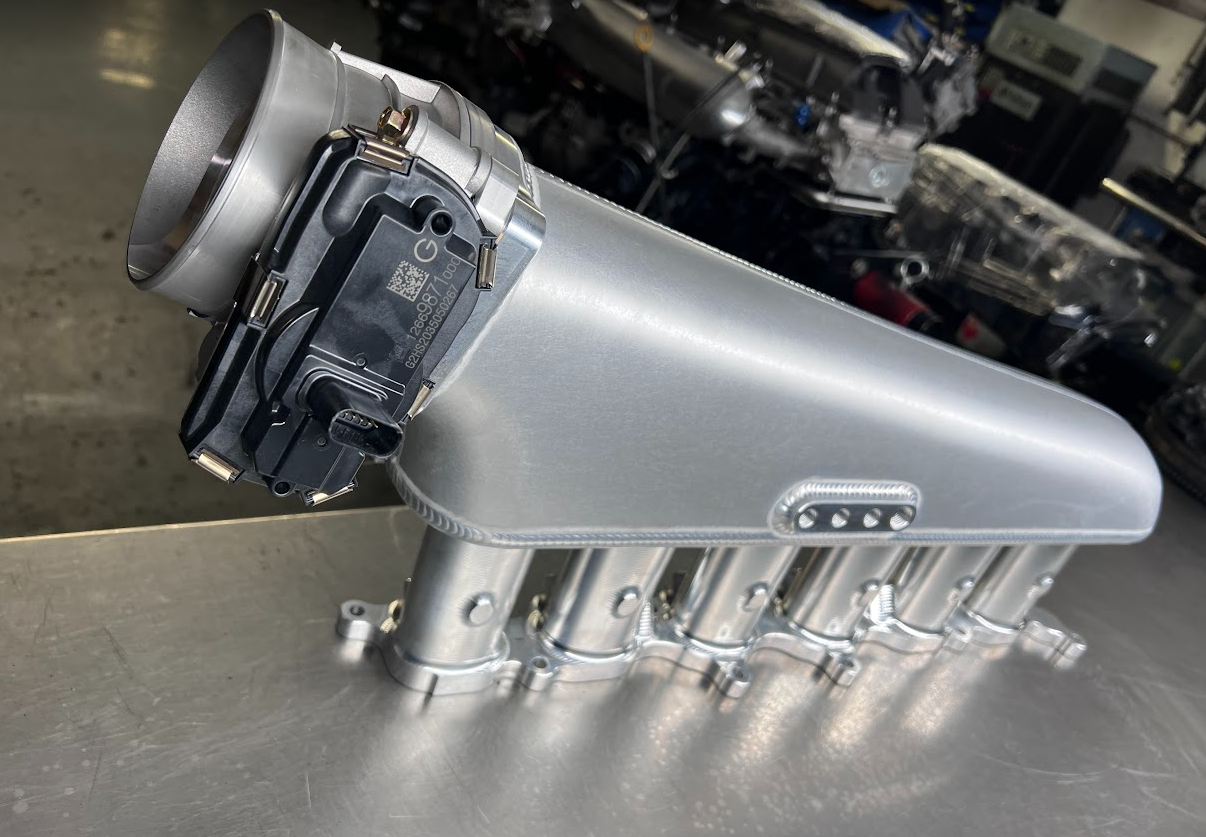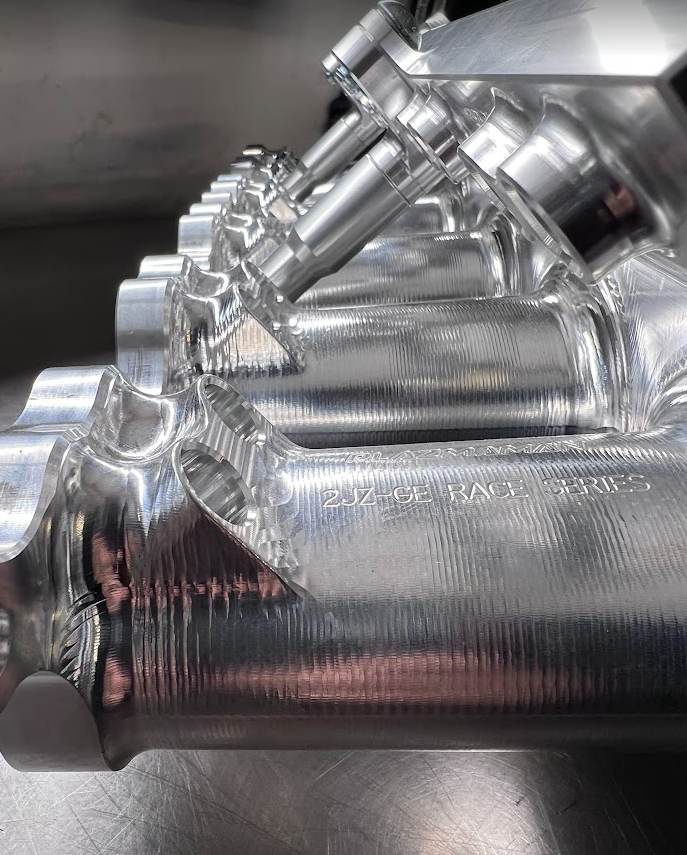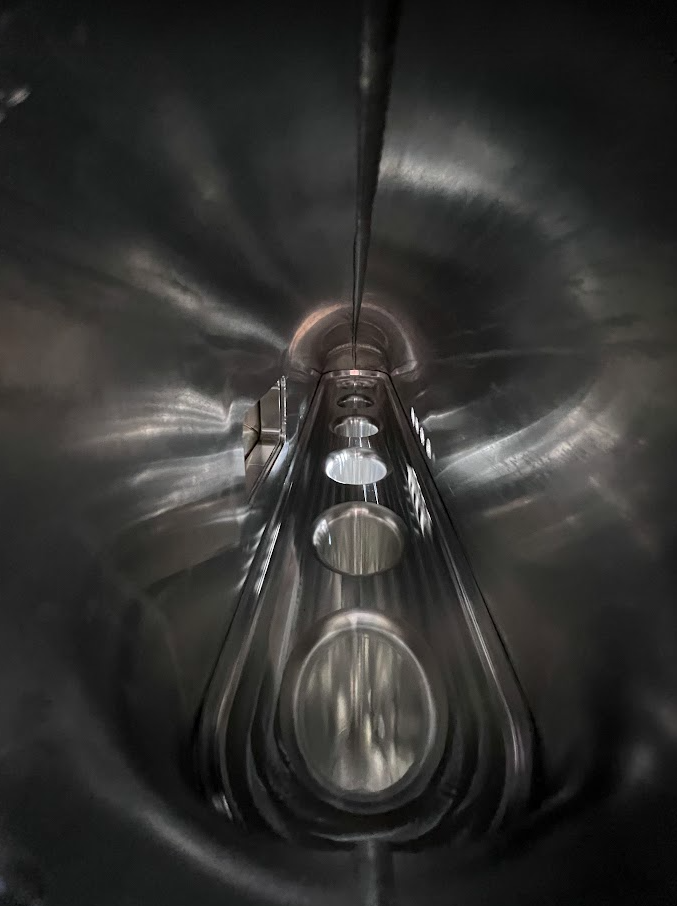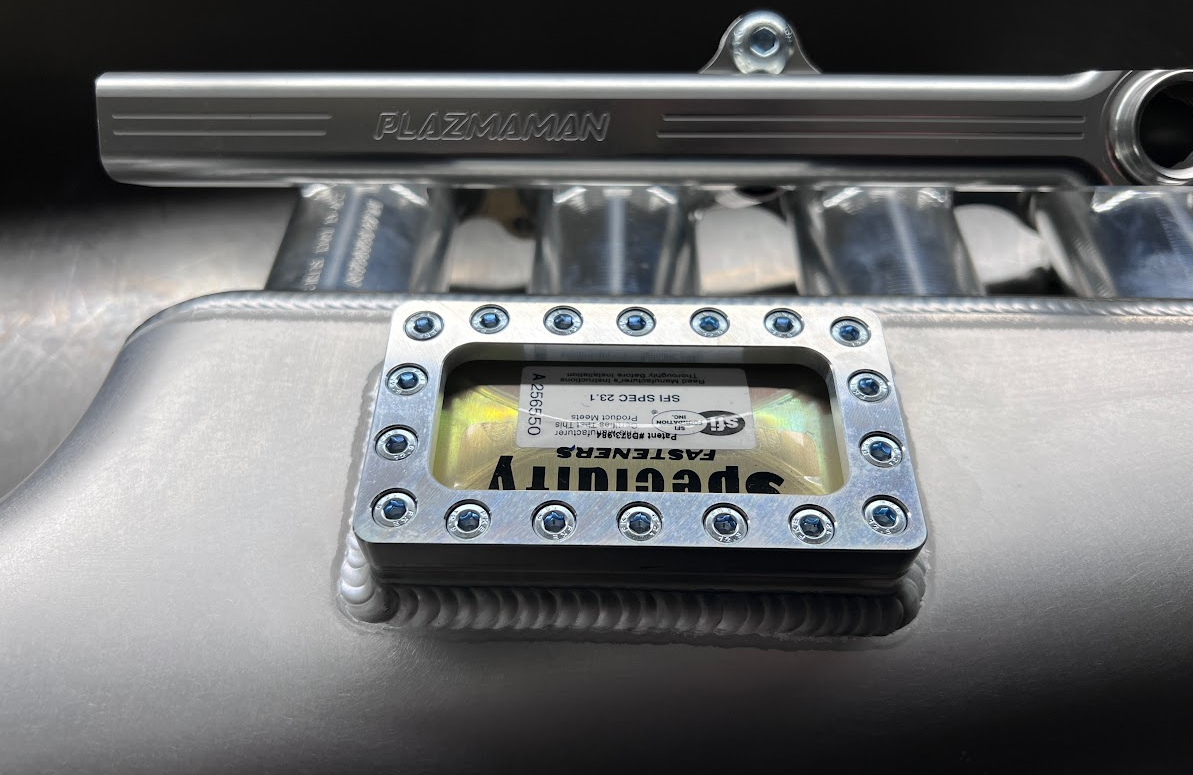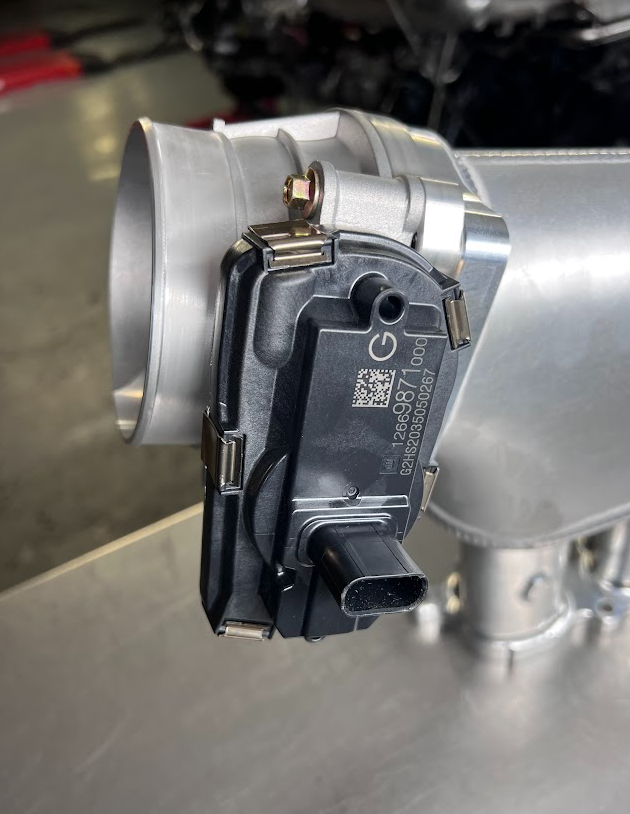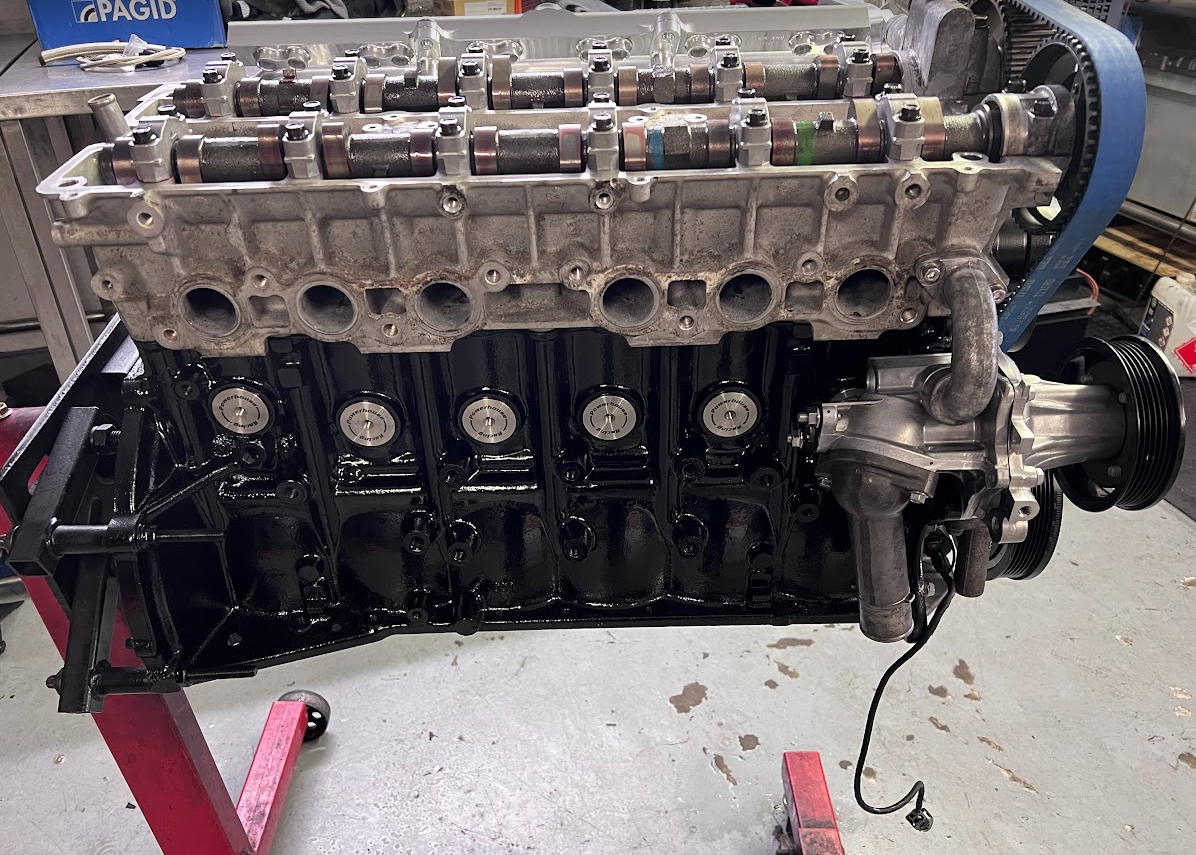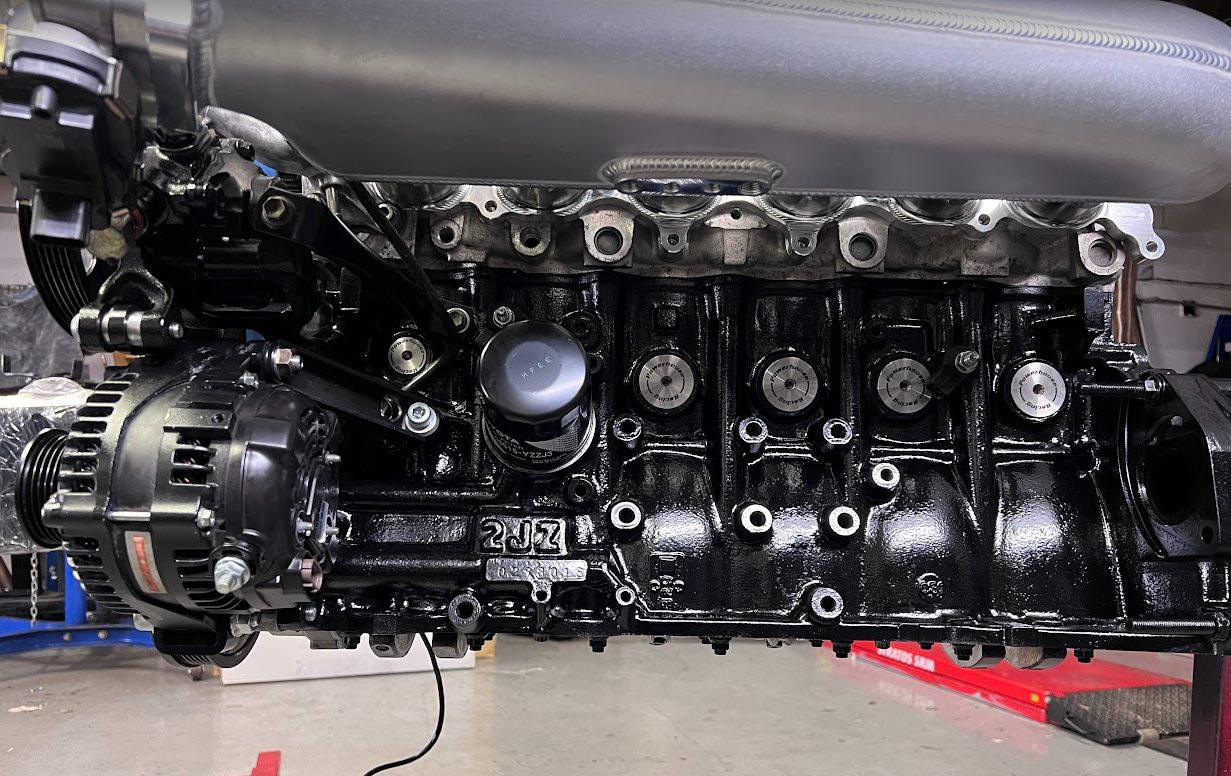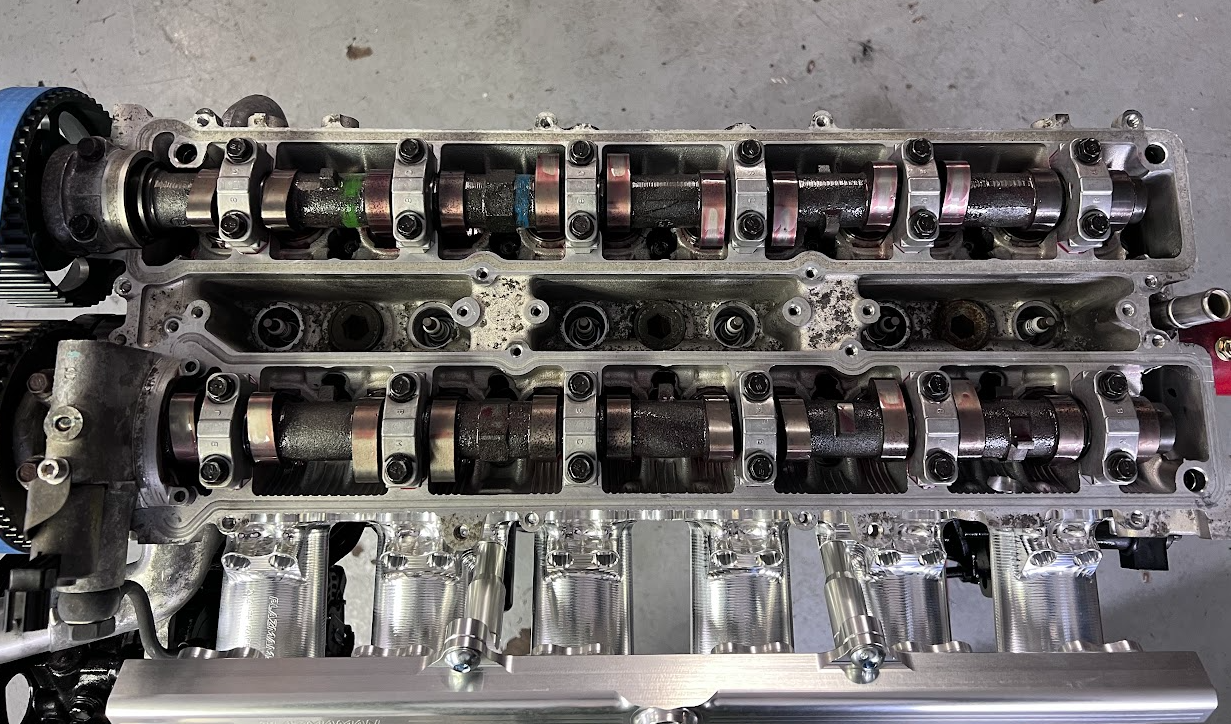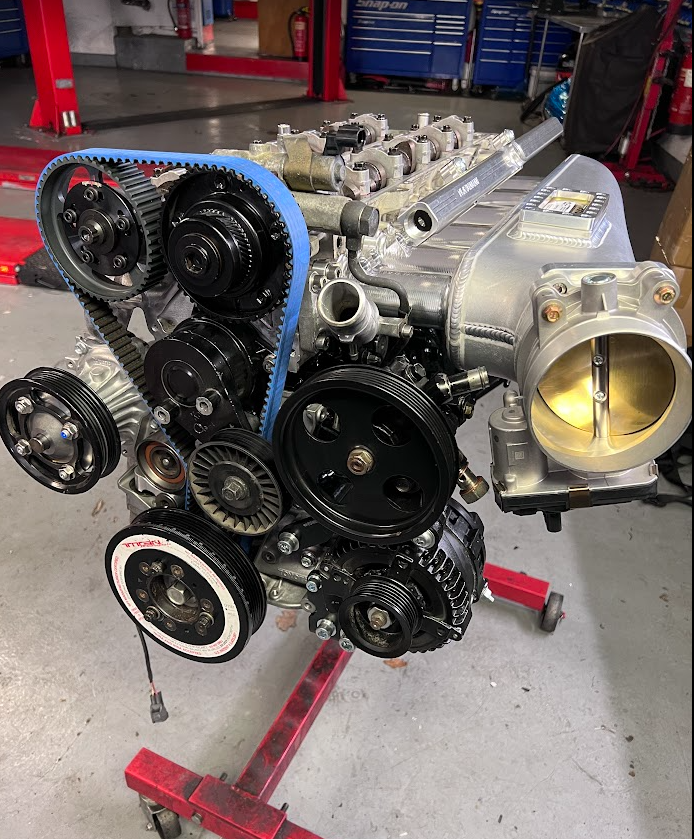After removing the head a few months ago I stripped the block down to inspect the state of the rotating assembly components. The bottom end didnt do a lot of miles, maybe 2000 miles or so, but used to get the shit kicked out it and occasionally had around 900ft.lbs of torque going through it, so I was expecting some accelerated wear in places.
Back when I built this engine, the machinist found some slight egging in the center main journals on the crank and wanted to sort this by undersizing the crank. Depending on who you speak to this is a nono with 2J cranks, but I was up for an experiment so he ground the main journals down and I've been running 0.25 oversize bearings since. I thought for sure after the abuse it had gone through I would see some sort of wear on the mains, but upon inspection they were still in great shape, so decided to run them again with the same bearings and continue to monitor how they get on.
The rod bearings had some slight wear on the edges of the bearing, but nothing abnormal or anything to made me worried so decided to keep them again.
So as everything is in good enough condition to reuse it will serve perfectly as my test mule whilst I gather some data once its up and running
Specs are:
Stock 3.0 Crank (0.25 Mains, STD Rods)
Factory Main Caps with ARP Main Studs
Manley Platinum Pistons 9:1 87mm
Manley H-Tuff Rods
Clevite Bearings
OEM Oil Pump
The aim of this shortblock is to support this next stage of development as best it can, getting abused mainly on the dyno and maybe a few events in the real world. I'm sure it will meet its demise at some point as the components arent exactly all that exotic so will be interesting to see where the breaking point is.
Whilst the engine was in pieces I had block sent to machinist just to give the bores the tiniest bore/hone possible, compared to the last bore finish we are going to try and very coarse finish on this to see what it looks like after seeing lots of E85, and if ring seal is any different with lots of boost relative to the last bore finish. Other than this rest of the block is going back together exactly how it was.
I want to forget how many sets of core plugs I've changed on my engines over the years as I normally install a new set when building a new engine. Luckily PHR to the rescue with this with their stainless core plug kit.
A bit pricey, but reusable so hopefully can transfer to any future blocks in future. Install/Removal is super simple with the threaded hole.
Stuck them in the freezer for an hour to let them shrink slightly, then using a long M8 bolt, knocked each one into place on the block in seconds. Was done in a few minutes, awesome!
Gave the block a clean and quick lick of paint and looks great with new core plugs
Then installed the crank back into block
Got pistons to go next and headwork at machinist was just finished, so might have a longblock ready to go by the end of the week.
Had a fairly productive weekend, but forgot my phone at home on saturday so missing lots of photos of the assembly of the longblock unfortunantely. Picked up from where I left off the other day and installed the pistons & rods back into the motor. Then installed my head and called it for the day.
Starting today I got to install some new fancy parts which I've been looking forward to.
First on the list was a new JUN cam pulley with ARP bolt
There are argueably more modern and more secure cam pulleys on the market these days, but I can't get over how cool this pulley looks to me, so opted to get a fresh one in from Japan for the build.
As I'm reusing my shortblock that originally came from an NA supra, the block is early style forging that was not provisioned for VVTi, so had to use one of these PHR adapters to allow me to install the factory vvti oil feed line. Had to bend the oil feed line slightly in places to reach this adapter and avoid the powersteering brace but fairly easy install otherwise.
And la piece de resistance is this Plazmaman intake manifold
This is specced for a 2JZGE, 12 Injectors on a single rail, nitrous burst plate & DBW throttle. Seemed a bit rude not to include the burst plate as I'll be dabbling a bit with nitrous on this setup. I only plan to run a dry shot pre throttle for spool aid/midrange torque, so the chance of a nitrous backfire is less than a full wet system, but for $100 it seemed like a good insurance just in case.
Quite a cool piece I think. The quality of the machining and welding are certainly up there.
The Plazmaman seems to be designed primarily for high power drag applications, so there are a few details in the way its been constructed which seem heavy duty. For example the runners are a single piece billet, the fuel rail has the beefiest mounts I've seen for a 2J. The rail itself has 3 AN10 Orifices that can be configured in multiple ways to supply/return fuel. The runner port size are larger than the factory head ports, and there are provisions under the runners for direct port nitrous should that be required.
Probably a bit OTT for what I need, but I appreciate having something over-engineered. The idea of this was to have an intake that I realistically never have to change in future, and the setup can grow into what the inlet can support should it go that direction in future.
The plenum can support multiple different style of throttles. I opted for a LS flange for a few reasons, compared to going with a bosch DBW which argueably are some of the best DBW's on the market.
The LS flange can support both LS Cable & LS DBW throttles, so multipurpose in that respect. I don't see myself ever going back to a throttle cable, but nice to have it as a backup without having to weld on a different flange.
In terms of DBW support with the LS flange there are a handful of OEM & aftermarket LS DBW throttles that have been used over the generations of LS motors, so plenty to pick from. However most of these are 10 years old + in terms of design. As mentioned, the Bosch DBW's are really prominent in the aftermarket for their reliability and ease of use, but I wanted to try something different that could hopefully match the standard of Bosch.
So I started digging into what the modern day equivalent OEM's like GM are using for DBW. This lead me to the LT5 engine used in modern corvettes. Compared to the earlier LS DBW's that used a voltage divider on a wiper contact which can wear out over time. The LT5 DBW uses contactless inductive sensors to operate the throttle. Compared to the old throttles this is "state of the art" and is rated "for life" operation. So on paper the LT5 unit should be better in every way.
Interestingly, the LT5 throttle does not use analog inputs for the TPS1a/TPS1b tracking. Instead it uses a digital signal communicating over the SENT protocol to send data regarding throttle position. Luckily the Motec ECU supports this so should be able to make this throttle work.
Another thing that interested me was the size of the throttle housing being 4'' and the butterfly being 95mm. Again, although its a bit OTT for my setup having a 4'' throttle housing, it means I could run a 4'' pipe from my intercooler outlet straight to the throttle without any need for reducers in the pipework. The idea again being that once this setup is in, I won't have to redo the intake side of the pipework in future if I go for more power.
By contrast the bosch DBW units "only" go to 83mm throttle size, which is still sufficient for more power than I'll ever need but in case there is any doubts on restriction, a 95mm throttle will allow for further headroom.
Having played with 102mm cable throttles on high powered 2J's before, it can be hard to get them to drive off idle as smooth as the OEM setup as cracking open such a large throttle even at small opening angles proportionally lets in a large amount of chargeair to the engine, so it can feel a bit like an on/off switch. I think the engineers at GM were thinking along a similar line as the LT5 throttle has been produced with a small ridge that reduces the amount of airflow through the throttle at small opening angles, so you can have a decent balance between low throttle driveability whilst having the airflow required at WOT on a large supercharged V8.
Between this ridge and the pedal to throttle mapping control on the ECU, I'm hoping I can have my cake and eat it in terms of airflow versus drivability at low engine speeds. Can't wait to see how this all plays out when I get round to calibrating it.
So back to business at hand.
With the longblock assembled, I started test fitting various components to the engine. This isnt the final fit, as once the car is back from RRS I want an engine to drop into the bay so I can start making decisions on a few things mechanically and cosmetically thinking about what colour scheme to go for. Then I can pull the engine back out, do some cleaning/painting and install whatever else needs to go on before going back in for real. So mainly test fitting what components I have spare from the last setup for now.
Starting with the front of the engine
This time round I've decided not to run any front covers on the engine. With the cam covers I plan on running I wont be able to seal the top half of the engine with a cover like OEM, so theres little point running the lower covers as if there is anything that goes near the cambelt at least now it will have somewhere to go rather than getting stuck inside a timing cover and causing havoc. I can also keep an eye on and service various components a little easier this way round.
The other big change on the front end is the alternator relocation, using a Tomei alternator relocation kit. I haven't run an A/C in years, so always had a free spot under the powersteering pump. The relocation kit serves a few purposes for me. Firstly, it keeps the alternator away from the heat of the turbo & manifold, whilst also streamlining the wiring more towards the inlet side of the engine. Secondly, with no alternator on the exhaust side I now I have more room to play with for turbos and intercooler pipework as it can sometimes be a bit of a squeeze with the alternator in the way.
I actually prefer the GE's coolant inlet/outlet locations to a GTE, as there is no longer a waterneck & pipework that has to cross the front of the engine. The in/out to the radiator is more of a straight shot and gives better accessibility to the front of the engine.
Previously I had run the manual aux tensioner dampener, but with the tomei relocation kit I think I will have to go without this and go back to an auto tensioner, unless I can get a fancy billet mount made up. Maybe a side project for the future, not the end of the world currently though.
Between the GE waterneck, rotated thermostat housing and the alternator being removed, it allows for the most compact setup I can manage whilst keeping the factory water pump.
Haven't decided yet on what style water pump hardline I'm going to run. I need to make some provisions for coolant feed/returns for the turbo and electronic wastegate. I will probably wait till the manifold and turbo are in place then figure out what sort of design is needed. The only thing for sure currently is that the coolant & oil lines on the exhaust side of the engine will be made from steel hardlines. Although there will be a few flexible sections I want hardlines to cover most of the areas where the heat is going to be most prominant to increase reliability.
Nothing too sexy happening on the intake side just yet, other than mounting the PS & Alternator relocation. Between the mechman alternator having a slightly larger housing than the OEM alternator and the VVTi adapter sitting further out than OEM, I had to modify the mounting brackets of the tomei kit slightly as it was fouling in places. Still have a bit more work to do on the rear alternator brace to the block, but it all fits as it should now.
Previously I had run a mocal oil thermostatic housing for my oil cooler, but the route of the oil lines went where the alternator now lives. So for the moment have just mounted an oil filter straight to the block. I will still retain a oil filter sandwich plate with a thermostat, but I think I'll move to a different product for this.
The head is a 2JZGE VVTi, running stock ports, stock valves and stock buckets with shims. Camshafts are Kelford T202-D (272/278) with ~10mm lift, with Kelford Beehive valve springs. The valve lift is probably cutting it a bit close with a stock bucket/shim setup, but for a baseline this setup will fit the bill. Also switched to some L19 head studs for that extra bit of clamping goodness.
The head is a bit grotty on the outside still, but for the moment is not a priority for me. Once the baseline of this setup has been established on the dyno, I'll remove the head and have valve seats, valve guides, valves and portwork done, so will save the cleaning/blasting of the head until then when the whole head has to come to pieces.
A few months ago I had ordered some plazmaman billet valve covers, and they were super nice. Compared to other billet covers I have seen, they designed a really good baffle system. Only problem was the covers I ordered were for a GTE non vvti, which obviously wouldnt work with a VVTi head. Annoyingly, Plazmaman haven't got VVTi valve covers ready yet. I've been told they will be available at the start of 2023, but if they dont come through in time then might have to go with hypertune or OEM VVTi covers. So for the moment I dont have any sexy covers.
In the next few days I'll get the sumps and some other components back onto the engine, ready for when the car is done being painted.
Michael Yazgic @ 0x33



